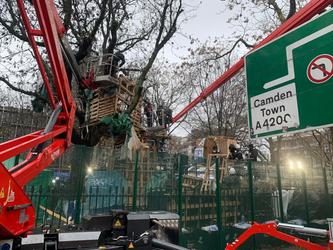The evolving protester landscape

As part of our series around the 30th anniversary of the National Eviction Team, we are taking a look at how the demographics and behaviours of protesters have changed over that time.
In the 1990s, protests were often local and focused on matters that had a direct impact on the community, such as bypasses, nuclear bases and airport expansion. The focus of activity was marches, petitions and lobbying, but tactics are now more about disruption and increased risk to personal safety taken on by the protesters.
Movements that attract protesters in recent years are now global, particularly those focussed on climate and the environment, as well as anti-capitalism movements.
Social media has also played a large role in facilitating the organisation and mobilisation of large-scale protests.
And last, but by no means least, increased alcohol and drug consumption has significantly changed protester behaviour.
Let’s look at each of these in turn.
Changing demographics
Movements like Extinction Rebellion (XR) are attracting a more diverse profile than protest groups in the 1990s and 2000s. A study by Aston University, Keele University and the University of Exeter in 2019 found that 10% of XR protesters were first-time demonstrators, twice the rate of ten years previously.
Their protesters are highly educated, with 85% having a university degree and a third with postgraduate qualifications. Around two-third identified as middle class.
Professor Clare Saunders, from the University of Exeter, said: “Our analysis shows one strength of Extinction Rebellion has been to involve people who are not natural protesters, and perhaps even less so natural lawbreakers, but who were already persuaded of the rightness of the climate cause, and frustrated with the inability of both politicians and lifestyle environmentalism to bring about change.”
Riskier tactics
Tactics have become more disruptive over the years, such as the motorway gantry and road blockages by Just Stop Oil and the multiple tunnel protests the National Eviction Team was dealing with along the HS2 planned route.
We have always had evictions where protesters have built and occupied tunnels, but the lock-ons in the tunnels are increasingly designed to be difficult to release, which puts the protester at greater risk if there is any problem in the tunnel. The protester tunnels are often poorly built and part of our role is to make them safe as a priority.
Recent developments also include bamboo towers, which are easily disguised when brought on site and quickly set up, but flimsy in construction and therefore hazardous.
Globalisation
Climate change protest movements, such as Extinction Rebellion and Just Stop Oil, are global groups with widespread support and access to many people. We increasingly find non-UK citizens on sites who are visiting the UK to take part in a protest.
This can provide challenges around communication where there is a language barrier. We have technology to support communication, but it is an increasingly frequent factor.
Social media
Social media has been a tool used to great effect by protesters to quickly mobilise and coordinate supporters and discretely share information. They also build awareness and pressurise governments through their posts and strategic use of hashtags.
Popular platforms are:
- X (formerly Twitter)
- WhatsApp - for secure communication
- TikTok
- YouTube
- Facebook - with older activists
The ubiquitous nature of mobile phones also means that every protester is a broadcaster and has a voice to the wider world that they did not previously have. Often, we find that the “spin” added to these broadcasts bears little connection to the actual events.
Journalists are also getting more involved in protests to take part, rather than being a dispassionate observer and reporter on events.
Substance abuse
We increasingly find protesters who are regularly taking drugs and/or consuming alcohol. This can impact on protester behaviour, with the lowering of inhibitions, a greater propensity to risky behaviour and often aggression towards our team.
It is an aspect that we train our team on how to identify intoxication and deescalate any resulting conflict, as well as incorporate into our health and safety risk assessments and planning.
In conclusion
The protester/activist profile and behaviour has certainly changed over the last 30 years. Given our position at the core of supporting clients impacted by this activity, we have evolved our techniques, equipment, training and processes to continuously adapt and evolve.



